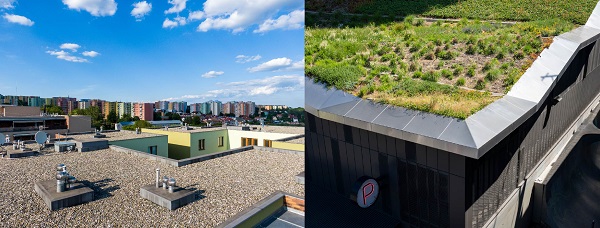Emerging as a prominent trend in sustainable architecture, green and brown roofs offer a transformative approach to rooftop utilisation. These innovative systems boast a multitude of environmental advantages, including enhanced insulation, stormwater management, and increased biodiversity. However, their intricate layered structures, incorporating vegetation, drainage systems, and filter fabrics, pose a distinct challenge: Leak detection!
Unlike traditional flat roofs, identifying and pinpointing leaks within green and brown roofs proves significantly more difficult. Early detection of leaks is paramount to ensuring the long-term viability and functionality of these valuable green spaces. This article delves into the complexities of leak detection in green and brown roofs, subsequently introducing a non-invasive solution that protects the integrity of your rooftop ecosystem. At Sensor, we understand the importance of proactive maintenance for all flat roof systems, that’s why we offer a specialised flat roof leak detection service specifically designed for these unique ecosystems.
Green vs. Brown Roofs: Understanding the Differences
While both green and brown roofs share the goal of creating a more sustainable rooftop environment, they differ in their design, purpose, and maintenance needs:
- Green Roofs: Designed to create a living space with a variety of plants. They require a complex layered system with waterproofing, drainage, filter fabrics, and a growing medium. Green roofs offer numerous benefits like improved insulation, stormwater management, urban heat island mitigation, and increased biodiversity. However, they come with a higher initial cost and require more ongoing maintenance, including watering, weeding, and monitoring plant health.
- Brown Roofs: Focused on mimicking natural habitats and encouraging the growth of local plants. Their design is simpler, utilizing waterproofing and drainage layers with shallower substrate layers or relying on natural seed dispersal. Brown roofs offer a lower-cost and lower-maintenance option compared to green roofs.
Unlike traditional flat roofs, both green and brown roofs have additional layers of vegetation, drainage systems, and filter fabrics. These elements can make it difficult to visually identify leaks or pinpoint their source. Traditional leak detection methods, like flood testing, are often impractical or even detrimental to the delicate ecosystems these roofs support. Flood testing is a method used to identify leaks in waterproof membranes, typically on flat roofs. It involves intentionally flooding a specific area of the roof with a controlled amount of water for a set period.
Flood testing, a common leak detection method for traditional roofs, is not ideal for green and brown roofs for several reasons:
- Disruption to Vegetation: Green roofs rely on established plant life. Flooding the roof disrupts the delicate root systems, potentially leading to plant death and requiring replanting efforts.
- Damage to Drainage Layers: Both green and brown roofs have drainage layers to manage water flow. Flood testing can overwhelm these layers, causing them to clog or malfunction.
- Inaccurate Results: The complex structure of green and brown roofs, with their multiple layers and vegetation, can mask the source of the leak. Flood testing might not reveal the exact location, leading to unnecessary repairs in the wrong areas.
- Time-consuming and Laborious: Removing vegetation and drainage materials for flood testing is a time-consuming and labor-intensive process. Replacing everything afterward adds to the overall cost and effort.
- Safety Concerns: The weight of a large volume of water can put stress on the roof structure, especially for older buildings. This raises safety concerns for those conducting the testing.
A 2023 study by the National Roofing Contractors Association (NRCA) highlights that proper maintenance significantly reduces the risk of leaks in flat roofs over time.
A Non-Invasive Solution for Green & Brown Roofs
Sensor DDS® technology provides a safe and efficient way to detect leaks in both types of roofs. This advanced system utilizes a special geotextile that is installed directly beneath the waterproofing membrane during the initial construction phase. The geotextile acts as a sensor grid, allowing us to identify even the smallest punctures or tears through a low-voltage electrical signal.
This approach offers several key advantages for both green and brown roofs:
- Non-invasive: No need to disturb the vegetation or disrupt the roof’s functionality.
- Early detection: Identifies leaks before they cause significant damage to the waterproofing membrane or building structure.
- Precise location: Pinpoints the exact location of the leak for efficient repairs, minimizing disruption to the rooftop ecosystem.
- Continuous monitoring: Optional permanent monitoring systems provide real-time leak detection for long-term peace of mind.
By incorporating Sensor DDS® technology into your green or brown roof project, you can ensure the long-term health and functionality of your sustainable rooftop. Early leak detection minimizes damage, prevents costly repairs, and safeguards the valuable ecosystem thriving on the rooftop.
Contact Sensor today to book a DDS Survey








